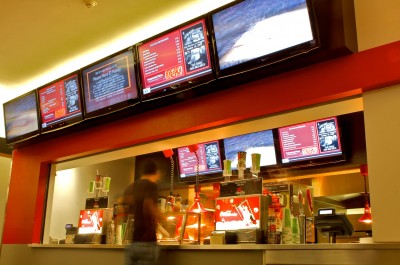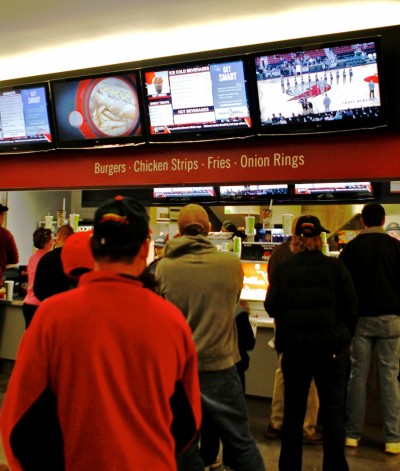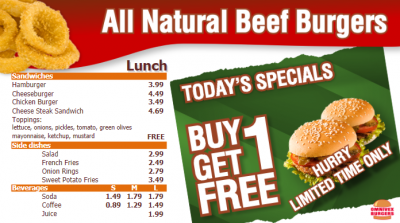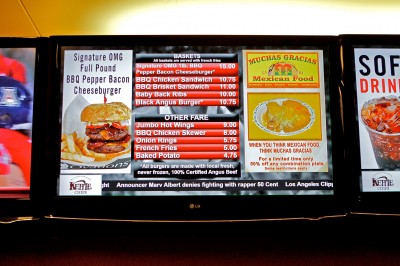Digital Signage: Doing more with menu boards
by all | 4 February 2013 8:30 am
 [1]
[1]Images courtesy Omnivex
By Jeff Collard
Digital signage has become an increasingly important visual aspect of many of today’s business environments, where rapid change and adaptability are crucial to success. As a medium, digital signage represents an effective way to manage complex or time-sensitive information.
One of the key factors is automation. By empowering organizations with digital signage technology, the management and updating of content—which could otherwise become onerous tasks—can be handled instantaneously, saving time and money.
The presence of digital signage has grown substantially in the food-service industry, for example, where its value is seen in the form of digital menu boards. More and more companies in this sector are recognizing the cost-cutting and revenue-increasing benefits of moving away from traditional static displays, including backlit signs and posters. From quick-service restaurants (QSRs) to stadiums, amusement parks to universities’ student centres, a wide variety of organizations are turning to digital signage to help improve efficiency, branding and sales.
Simplifying customization
One of the benefits of deploying digital menu boards is the capability to segment on-screen content, allowing space not only for lists of menu items and prices, but also for in-house promotions and externally sourced advertising.
 [2]
[2]One of the advantages of digital menu boards is the ability to segment templates for on-screen layout, with space not only for menu items and prices, but also for promotions and externally sourced ads.
Further, when configuring content playlists within their digital signage software, companies can create rules to dictate when and where specific types of content should or should not be displayed, based on metadata (i.e. information about the content).
A sports arena, for example, may be required to stop serving alcoholic beverages after a certain inning or period in a game. With digital signage, it becomes easier to showcase beer early in the game and then stop promoting it after a set point in time. The ad is simply removed from the screen and replaced with other content.
Similarly, if a certain product is selling well and crosses a particular threshold, the software may be set up to promote that item more prominently as part of the screen display, taking advantage of the current trend. Digital signage systems can handle these functions without needing users to create multiple, complex playlists.
While external advertising does not appear on all digital menu boards, it has become a key revenue generator for food-service providers in arenas and stadiums, thanks to rule creation and metadata. In these scenarios, ad placement is tied to ongoing events. When a well-known athlete plays a great game or reaches a career milestone, for example, his/her jersey can be heavily promoted. Since this type of advertising only operates within a short, designated window, making effective use of limited time is critically important to its success.
In addition to food and beverage sales, merchandising and sponsorship revenues are a key part of the arena and stadium business model. For a 20,000-person sports facility, ad space typically generates more than $500,000 each year, which can more than justify the upfront cost of implementing a digital signage network.
Improving efficiency
Indeed, while digital menu boards may require a more sizable investment at the outset than traditional static displays, the long-term payoff can be substantial.
For one thing, content creation and distribution can be centrally managed at the corporate level. One employee at a head office can develop and send out content to hundreds of different restaurants, reducing the local burden of installing and changing out backlit signs. Large-scale changes to promote new products or update caloric information can be handled instantly. All of this helps save time and drives down labour costs.
 [3]
[3]Digital menu boards can cycle through video clips to ensure customers in line see as much different content as possible, which has been shown to reduce their perceived waiting time.
The same benefits can be applied to marketing and promotional activities, particularly for large, franchised restaurant chains. In the past, new materials would need to be created, distributed to various locations, reported on and discarded. This process required significant time and effort, with costs associated with developing content for and printing posters and backlit signs. Additionally, if these pieces were ever late getting to or being installed at one of their destinations, there was a loss of promotional opportunity.
With the advent of digital menu boards comes the ability to distribute new content instantaneously, without the need to ship, install or dispose of physical materials for each promotional campaign. A new menu item can be test-marketed at select locations with ease, requiring no additional costs or time, aside from that involved in creating the new content. The head office can also retrieve and analyze results of the campaign immediately.
An example would be a fast-food chain simultaneously promoting regular fries at one location and curly fries at another, to see if customers are more receptive to one than the other.
In today’s economic environment, where budgets are tight and expectations are high, these methods for reducing costs, streamlining processes and improving the bottom line have been key in driving the implementation of new digital signage systems.
Expanded functionality
In the past, with static signage featuring new menu items and promotions, it was difficult to keep all of this information up-to-date. In-store specials and pricing might change weekly or even daily, so it was nearly impossible to ensure all displays remained relevant. By the time a particular franchise in a restaurant chain was notified of a menu change, the process of receiving new artwork and replacing old content often used up valuable promotional time.
Digital menu boards, on the other hand, can integrate real-time data into on-screen content. They can connect to companies’ existing data resources, such as point-of-sale (POS) systems, to reflect changes instantly.
 [4]
[4]Quick-service restaurants (QSRs) may change their in-store specials weekly or even daily, so digital signage can prove highly valuable by integrating real-time data into on-screen content.
This functionality is also valuable when QSRs vary their menus depending on the time of day. Digital signs can be updated to showcase breakfast, lunch and dinner items. Gone are the days when in-store employees had to change out the menu boards manually; now they can focus on their key job functions with regard to serving customers.
Other factors can also be used as triggers for dynamic content. At downtown Toronto’s Air Canada Centre (ACC), a stadium owned by Maple Leaf Sports & Entertainment (MLSE), beer provider Molson Coors catches fans’ attention with digital signage by changing the colour of its displayed mountain logos based on temperature. This feature reflects a recent marketing campaign, where the same logos on product labels changed colour when the drinks reached their ideal cold temperature. It also takes advantage of the ACC’s facility-wide digital signage network (see Sign Media Canada, September 2012, page 42), which was designed with ambient environmental effects in mind, as a way to create unique and memorable experiences for visitors.
Menu layouts may also vary depending on specific displays’ locations and configurations. A good example of this type of difference is between the content for in-store and drive-thru menu boards. Outdoor boards generally need to be positioned differently, due to space restrictions, with information spread across one or two narrow, vertical screens. Rather than having to redesign all content for outdoor and indoor use, digital signage content management software allows the ‘core’ layout to be developed once, then reused in multiple configurations.
Some chains develop menus with slight variations for different franchises. This could be extremely labour-intensive, but by breaking content down into components and then building up dynamic menus as a combination of these parts, digital signage can generate a large number of variations with very little work.
Another benefit of digital menu boards is improved inventory management. If a food item sells out, data from the POS system can automatically trigger the digital signage software to remove that item from the displayed content.
Compelling content
When creating customer-facing content, important factors include compelling brand messaging and esthetic appeal. There is only a short ‘window’ with menu boards to catch customers’ attention and entice them to make a specific purchase.
Digital menu boards are well-suited to this purpose, featuring motion and bright graphics. While posters may fade or yellow, digital signage need never look old or tired. Its content can remain fresh and vibrant.
Video content, for example, is a much more appealing way to showcase signature items and specials than static imagery. Digital menu boards can cycle through video clips to ensure customers in line see as much different content as possible. As an additional bonus, digital signage has been shown to reduce their perceived waiting time.
It is common for large food-service providers to require consistent branding to be maintained across many franchised locations, while still allowing some flexibility for displaying and updating local content, such as business hours on screens visible from outside. By using digital signage software with user-permission capabilities, these chains can ensure their franchisees adhere to company-wide standards, with corporate control over key brand elements, but also can provide and change local content as relevant to their customers.
 [5]
[5]Other elements can also be added to the screen layout. In a stadium, for example, a ‘ticker’ might feature sports-related news updates.
Engaging customers
As mentioned, digital menu boards can boost sales of related merchandise, such as the jersey of a star athlete when he/she scores a goal in an arena. Another example is a QSR promoting a kids’ meal that comes with a toy tying in with a new movie or TV show.
Some companies are choosing to incorporate mobile and social media elements into their digital signage strategy. They might encourage customers to tweet with a given hashtag, for example, for the chance to win tickets to a game or other event.
These types of campaigns use digital signage to provide a more interactive and engaging experience for customers, which can lead not only to a boost in sales, but also to quick and easy access to a large pool of sample data for further marketing activities.
Indeed, one of the key differentiators between traditional and digital signage has been the ability to incorporate specialized data, both to drive content to the right people at the right time and to measure the results. In these ways, digital signage—including but not limited to menu boards—is changing how businesses manage their content and communicate with their customers.
Jeff Collard is president of Omnivex, which develops digital signage software in Concord, Ont. For more information, visit www.omnivex.com[6].
- [Image]: http://www.signmedia.ca/wp-content/uploads/2014/02/Omnivex-at-Portland-Trail-Blazers-Rose-Garden-Arena_01.jpg
- [Image]: http://www.signmedia.ca/wp-content/uploads/2014/02/Omnivex_Sample-Menu-Board-2.png
- [Image]: http://www.signmedia.ca/wp-content/uploads/2014/02/Omnivex_Portland-Trail-Blazers_Menu-Boards-5.jpg
- [Image]: http://www.signmedia.ca/wp-content/uploads/2014/02/Omnivex_Sample-Menu-Board.png
- [Image]: http://www.signmedia.ca/wp-content/uploads/2014/02/Omnivex_Portland-Trail-Blazers_Menu-Boards-4.jpg
- www.omnivex.com: http://www.omnivex.com
Source URL: https://www.signmedia.ca/doing-more-with-menu-boards/